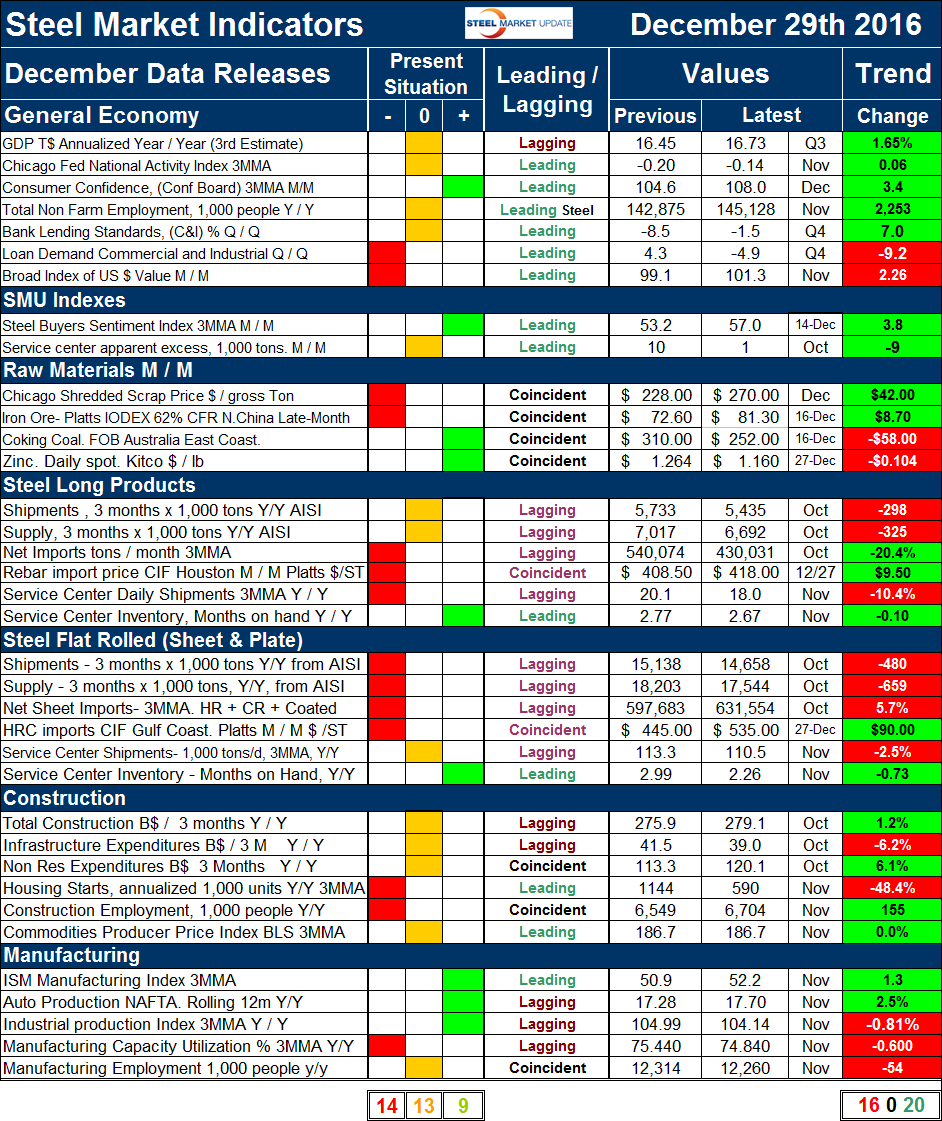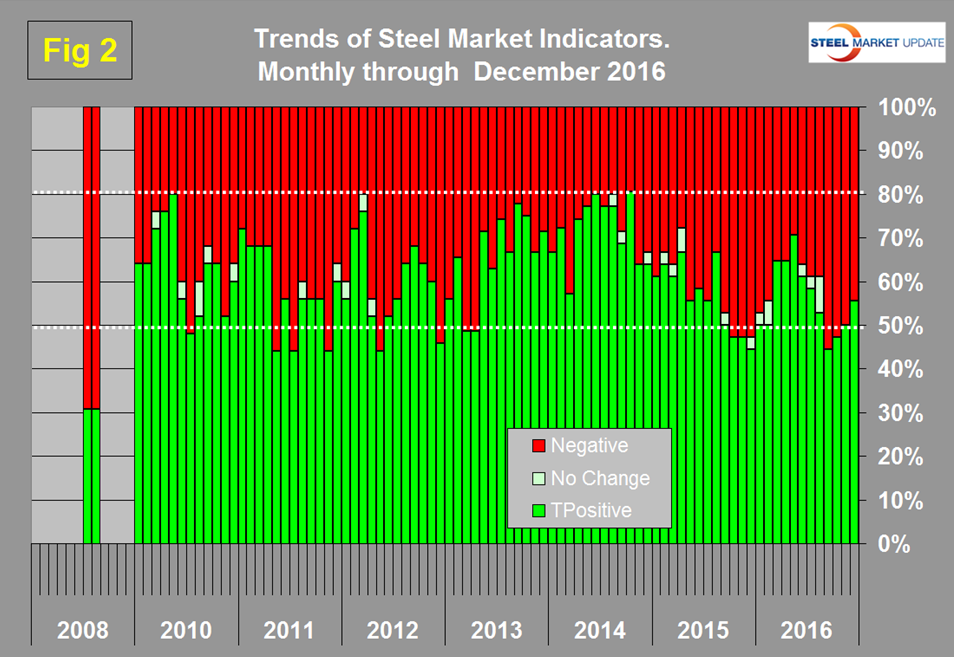SMU Data and Models

Steel Industry Key Market Indicators
Written by Peter Wright
January 3, 2017
An explanation of the Key Indicators concept is given at the end of this piece for those readers who are unfamiliar with it. This will explain the difference between our view of the present situation which is subjective and our analysis of trends which is based on the latest facts available. Looking back from the end of December we see that our view of the present situation deteriorated throughout 2015, improved through September this year and has been flat for the last three months of the year. Trends improved from December last year through May, then reversed course and deteriorated for four straight months through September before picking back up in the last three months. It is quite common for these two attributes to move in opposite directions as trends tend to lead the present situation by about four months.
![]() The total number of indicators considered in this analysis is currently 36.
The total number of indicators considered in this analysis is currently 36.
Please refer to Table 1 for the view of the present situation and the quantitative measure of trends. Readers should regard the color codes in the present situation column as a quick look at the current market condition. The “Trend” columns of Table 1, are also color coded to give a quick visual appreciation of the direction in which the market is headed.
All data included in this table was released in December, the month or specific date to which the data refers is shown in the second column from the far right and all data is the latest available as of December 31st, 2016.
Present Situation
There was an increase of one negative and one positive indicator since we last published on November 30th and a decrease of two in the neutral category. Our intent in using the word neutral is to say that this indicator is considered to be in the mid-range of historical data. Changes that occurred in the last month were as follows. The Chicago Fed National Activity Index rose above negative 0.2 on a three month moving average (3MMA) basis which changed our assessment from negative to neutral. The CFNAI is a composite of 84 sub-indices and is widely regarded as an effective leading indicator. In the flat rolled steel section both mill shipments and apparent supply were re-classified from neutral to negative however the latest data we have is for October and we anticipate that both these measures will improve as data becomes available for the balance of the year. In the manufacturing section the ISM manufacturing index was re-classified from neutral to positive as its 3MMA moved back above 52. There were no changes to our perception of the present situation of raw materials, the SMU indices, long products, or construction indicators. We currently regard 9 of the 36 indicators to be positive, 13 to be neutral and 14 to be negative on a historical basis. An overall view of the color codes in the present situation columns show that in every section the present situation is mixed suggesting a market that is looking for direction.
Figure 1 shows the change in our assessment of the present situation since January 2010 on a percentage basis.
The number of indicators classified as positive peaked at 47.2 percent in October 2014 and steadily declined to 11.1 percent in the three months through last December. In 2016 the proportion of positives increased through the September data after which there was a leveling. Based on the proportion of indicators that we consider neutral we still have present situation with no particular direction with plenty of room for improvement. The real point that we are trying to identify is, “Which way is it going.”
Trends
Most values in the trends columns are three month moving averages to smooth out what can be very erratic monthly data. The proportion of indicators trending positive through December 30th was 55.6 percent with 44.4 percent trending negative and zero indicators unchanged. In October 2014 the proportion trending positive was 80.6 percent which coincided with the highest month of total steel supply since the recession. There was a steady deterioration through 2015. At the end of 2015 the proportion trending positive fell below 50 percent for the first time since March and April 2013. Between December 2015 and May this year there was a surge in positives from 44.4 percent to 70.6 percent. There was a negative turnaround between May and September when the proportion of indicators trending positive returned to 44.4 percent, then in October, November and December the positive trends improved to 47.2 percent, 50 percent and 55.6 percent. Figure 2 shows the trend of the trends and the pre-recession situation at the far left of the chart. In August 2008 over 2/3 (69.2 percent) of our indicators were trending negative and the steel market crashed in September of that year. Trend changes in the individual sectors since the end of November are described below; please note in most cases this is not December data but data that was released in December for previous months.
The general economy with the exception of commercial and industrial loan demand and the value of the US $ is trending positive. At the end of September all seven indicators were trending positive, this declined to five in October, to four in November and back to five in December. The change in December was a return to positive for the Chicago Fed National Activity Index. In the SMU index section there was a reversal in sheet steel buyer’s sentiment which improved from 53.5 percent positive in November to 57 percent positive in December (Figure 3).
The service center excess inventory which is a proprietary SMU calculation continued to decline and reached almost zero in November. We regard an inventory surplus to be a sign of weak pricing power and at present the virtual lack of surplus is encouraging (Figure 4).
In the raw materials section all indicators were trending positive in November but in December both coking coal and zinc reversed course with price declines. Both iron ore and scrap continued their upward progress. In the long products section the only trend reversal was that net imports declined. In the flat rolled section, net imports did a reversal and increased. There were no other trend changes for flat rolled or long product sectors. In the construction sector the only change was that the producer price of commodities increased which we regard as positive because a high PPI tends to promote industrial construction. In the manufacturing sector the ISM index reversed direction and improved as described above.
We believe a continued examination of both the present situation and direction is a valuable tool for corporate business planning.
Explanation: The point of this analysis is to give both a quick visual appreciation of the market situation and a detailed description for those who want to dig deeper. It describes where we are now and the direction in which the market is headed and is designed to give a snapshot of the market on a specific date. The chart is stacked vertically to separate the primary indicators of the general economy, of proprietary Steel Market Update indices, of raw material prices, of both flat rolled and long product market indicators and finally of construction and manufacturing indicators. The indicators are classified as leading, coincident or lagging as shown in the third column.
Columns in the chart are designed to differentiate between where the market is today and the direction in which it is headed. Our evaluation of the present situation is subjectively based on our opinion of the historical value of each indicator. There is nothing subjective about the trends section which provides the latest facts available on the date of publication. It is quite possible for the present situation to be predominantly red and trends to be predominantly green and vice versa depending on the overall situation and direction of the market. The present situation is sub-divided into, below the historical norm (-) (OK), and above the historical norm (+). The “Values” section of the chart is a quantitative definition of the market’s direction. In most cases values are three month moving averages to eliminate noise. In cases where seasonality is an issue, the evaluation of market direction is made on a year over year comparison to eliminate this effect. Where seasonality is not an issue concurrent periods are compared. The date of the latest data is identified in the third values column. Values will always be current as of the date of publication. Finally the far right column quantifies the trend as a percentage or numerical change with color code classification to indicate positive or negative direction.

Peter Wright
Read more from Peter WrightLatest in SMU Data and Models

SMU Survey: Sheet lead times ease further, plate hits one-year high
Steel buyers responding to this week’s SMU market survey report a continued softening in sheet lead times. Meanwhile, plate lead times have moderately extended and are at a one-year high.

SMU Survey: Buyers report more price flexibility from mills
Nearly half of the steel buyers responding to this week’s SMU market survey say domestic mills are showing increased willingness to negotiate pricing on new spot orders. This marks a significant shift from the firmer stance mills held in prior weeks.

SMU Survey: Buyers’ Sentiment Indices fall
Current Sentiment Index dropped six points to +42 this week compared to two weeks earlier. It has fallen in every successive survey since reaching a 2025 high of +66 on Feb. 19.

March service center shipments and inventories report
Steel service center shipments and inventories report through March 2024.

Apparent steel supply contracts in February
The amount of finished steel that entered the US market in February receded from January’s peak, according to our analysis of Department of Commerce and American Iron and Steel Institute (AISI) data.





